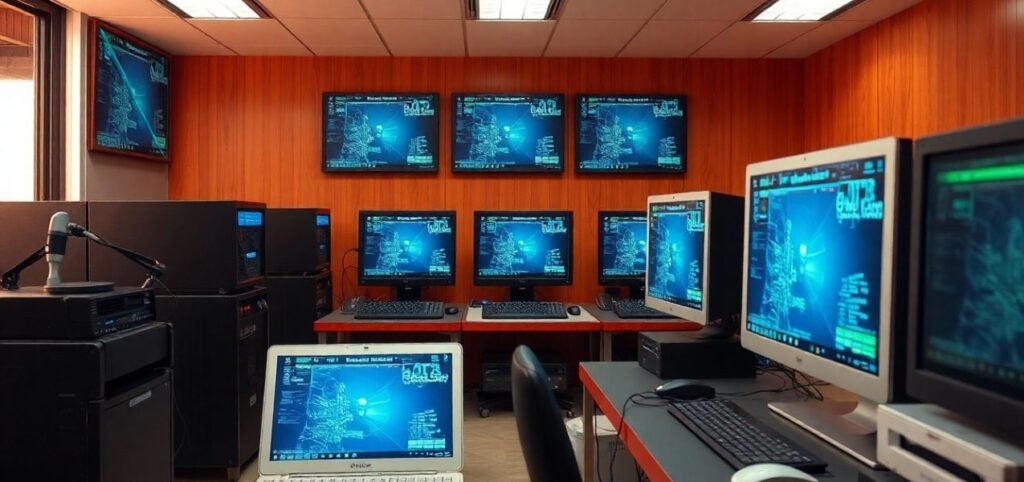The advancement of computers can be done under generational classification. Every generation is a major advancement in technology that has helped to define and form the capacities and uses of computers. This paper aims to offer a brief description of the five generations of computers, their features, roles, and impacts on the society we live in today.

First to Fifth Generations Computers Overview
First Generation: Vacuum Tubes (1940s-1950s)
The first generation of computers was between 1940 and mid-1950s. This era was dominated by vacuum tubes necessary for the work of the first computers. These huge machines were power guzzlers, and during operation, one could feel the heat that came from the machines. A typical artifact of the first generation of computers is the Electronic Numerical Integrator and Computer (ENIAC). It was mainly applied in solving advanced problems like calculations for the trajectory of artillery for the military.
First-generation computers as powerful as they were had two main drawbacks: low speed and relative rigidity of the programming. Some even had to use low-frequency languages that required direct interaction with the hardware, and they always involved a lot of alterations. However, these early Pc’s provided the necessary foundation for the next developments of technology.
Second Generation: Transistors (1956-1963)
The second-generation computers emerged in the mid-1950s with the outbreak of transistors in PC technology. This innovation displaced vacuum tubes, making PCs small, efficient, and reliable. Transistors made PCs faster, and sometimes faster, more power-efficient, and less prone to thermal problems.
During this period, programming languages started evolving in terms of their capabilities. Higher-level languages, for example, COBOL and FORTRAN, were developed, making programming a preserve of more people than before. The second generation also brought with it the concept of magnetic core memory, enhancing the probability of storing and getting back data. PCs also become much more universal, especially in business applications, educational centers, and science.
Third Generation: Integrated Circuits (1964-1971)
The third-generation computers, which started in 1969, incorporated ICs, which stand for Integrated Circuits. The coats of material being utilized for these chips enabled several transistors to be packed in one semiconductor, which has made PCs cheaper, smaller, and more powerful at the same time.
The third generation of computers was marked by improved speed on the one hand and, on the other, a better capacity for working with large amounts of data. As the high-level programming languages gained momentum, the software complexities increased as form-interface and operation gains were achieved. During this period, PC integration into businesses and eventually in households increased the reliance on automated systems.
Fourth Generation: Microprocessors (1971-Present)
The fourth generation, set in 1971, was marked by the growth of microprocessors, or microprocessors; in other words, they were compact digital integrated circuits containing all parts of a computer’s CPU. As a holder of this innovation, I brought the change in computing and the production of personal (PCs) possible with mass transit.
Computers of this generation got quite smaller in size, comparatively cheaper, and easy to use. The proliferation of personal computers in those earlier years triggered a technological revolution, especially after the creation of friendly operating systems with graphical user interfaces. Creswell, Orna, and Goodwin, Terry Companies like Apple and IBM were the ones that helped pioneer the use of PCs for single users, which radically altered the makeup of technology.
Fifth Generation: Artificial Intelligence and Beyond (Present and Future)
Moving straight into the present day, we are welcomed by the fifth generation of computers, namely AI and quantum computing. Though currently in development stages, it implies a vast discursive shift in how PCs process information and learn from it, much like human cognition.
Machine learning and natural language processing are samples of applied AI technologies; thanks to them, computers can easily translate languages and recognize images at a very high level. Quantum computing, though it is in its early stages, has the possibility of discovering highly complex questions at a remarkable velocity.
Conclusion
The evolution of computer generations defines great progress from large-dimensioned and slow-working machines based on vacuum tubes to compact, smart machines based on artificial intelligence systems. One has made improvements on the other to function better, to be more accessible, and to impact society more profoundly. As we decided to stay future-oriented and give remarkable resources to artificial intelligence and quantum computations, the future in technologies still looks very bright and filled with potential. Knowledge of these generations is useful for putting into perspective an appreciation of the role of PCs in our lives and the larger society.

Pingback: Is CyberPowerPC Good? A Best Guideline - Tech Passion